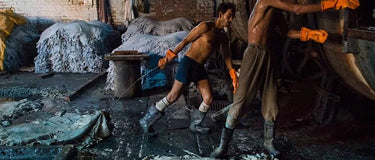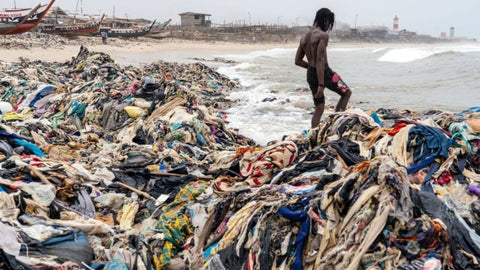
Today, please bear with us because we’re getting on our high horse about something that makes us a little bit angry and perplexed. As you may or may not know, we’re pretty much a chilled-out company, so it takes a lot for us at LUC8K to lose our sh*t. The bright orange idiot, global warming, fat cats, the price of yoghurt, pointless wars, the Kardashians, being forced to take our shoes and belts off in airports, Starbucks refusing to take cash, the list goes on. But let’s focus on ‘Pleather’. Even the word itself makes us want to smash things up and scream until our neighbours call the police.
Pleather is the perennially awkward cousin of luxury. It’s like a very bad David Beckham lookalike, or a wedding DJ with a mullet who thinks he’s Fat Boy Slim.
The thing about Pleather
The thing is, as more people seek out vegan fashion alternatives, pleather can seem like an ethical option. But these pieces, often made from fossil-fuel based plastics, can have a major environmental impact
Pleather, short for "plastic leather," has often been touted as the eco-friendly alternative to traditional leather. Made from synthetic materials such as polyurethane or PVC, pleather boasts a lower price tag and claims to alleviate concerns about animal welfare. However, upon closer inspection, the sustainability of pleather begins to unravel like Will Smith at the Oscars. If pleather was a human being, we’d give it a slap and tell it to go f*ck itself.
Harsh? Maybe. Maybe not. Let’s see. We’ll start with the production process. While it's true that pleather doesn't involve the direct slaughter of animals, its environmental footprint is far from benign. The manufacturing of synthetic materials requires the use of petrochemicals, which contribute to greenhouse gas emissions and rely on non-renewable resources. Additionally, the production of pleather often involves toxic chemicals and additives, posing risks to both human health and the environment. So, not a good start.
Pleather is a waste of time
But the environmental impact of pleather doesn't end there. Unlike real leather, which is biodegradable and can potentially last for decades with proper care, pleather has a significantly shorter lifespan. Its synthetic fibers break down over time, releasing microplastics into the environment, contributing to the global plastic pollution crisis. In fact, a study published in the journal Environmental Science & Technology found that synthetic textiles, including pleather, are a major source of microplastic pollution in the oceans. So, it’s not just us. Dolphins and sea turtles hate pleather with a passion too.
Moreover, the disposal of pleather presents its own set of challenges. Unlike real leather, which can naturally decompose and return to the earth, pleather remains intact for hundreds of years, further perpetuating the cycle of waste and pollution. In a world grappling with the consequences of plastic pollution, the proliferation of synthetic materials like pleather only exacerbates the problem. Pleather is basically that annoying friend who is nice to your face but goes around telling everyone that you murdered your cat.
Leather: The sustainable choice
In contrast, real leather, when sourced responsibly, can be a nice, honest, sustainable choice. Leather is a by-product of the meat industry, meaning that it utilizes parts of the animal that would otherwise go to waste. Additionally, like LUC8K, many leather manufacturers have implemented environmentally friendly practices, such as using vegetable-based tanning processes and reducing water consumption.
Furthermore, real leather possesses qualities that pleather simply cannot replicate. Its durability and longevity make it a worthy investment, capable of withstanding years of use and developing a rich patina over time. In a culture inundated with fast fashion and disposable trends, choosing quality over quantity is an act of sustainability in itself.
While pleather may offer a seemingly eco-friendly alternative to real leather, its environmental impact tells a different story. From the production process to its end-of-life disposal, pleather falls short in comparison to its natural counterpart. As consumers, it's important to look beyond the surface and consider the true cost of our choices.
Kylie Jenner is full of it
Kylie Jenner launched her latest brand, KHY, with much fanfare and a collection of faux leather garments. The pieces, while impeccably stitched and seemingly stylish, carry a dark secret - they're made from massive amounts of plastic. The pieces seem well made. The thick and heavy material is handsomely stitched – almost as if the clothes were made from actual leather. Except they are made from industrial quantities of plastic, and they will be with us and future generations forever. Quite the legacy, Khy. Bravo.
The high street is also full of it. At Marks & Spencer, a pair of high-waisted “leather look” leggings has been selling fast online. At Shein, we lost count of how many pages we had to scroll through to get to the end of the list of “faux leather”. It’s overwhelming.
Most pleather, faux leather and vegan leather is a product of the fossil fuel industry, and there is no system in place to recycle it. We are simply creating a material monster, its production contributing to the climate crisis and its pollution destroying our ecosystems. Faux leather – PU [polyurethane leather] or PVC [polyvinyl chloride] – is a problematic material due to its synthetic nature, which contributes to environmental harm during production and disposal.
For many, animal-free materials are an ethical choice. But like a vegan burger at a fast-food outlet, a faux leather skirt isn’t necessarily the healthy or environmentally friendly option.
The solution is not simple. Currently, there is no legislation regulating the production or use of these materials. While single-use plastic bags have been taxed, there is nothing to stop a brand spewing out plastic fashion accessories, and it’s clear that pleather has infiltrated every corner of the fashion world.
Faux Leather Propaganda
At LUC8K, we might be somewhat biased when it comes to this subject, but let’s cut the BS and cut through the pleather propaganda. Faux leather is nothing more than a plastic imposter, masquerading as the real deal while failing to deliver on durability, longevity, or natural compostability. It's like trying to pass off a tofu burger as a gourmet steak - sure, it might fool a few taste buds, but true connoisseurs can see right through the charade.
There is hope though, and we’re not the only ones working to produce more ethical real leather items. Designer Alice V Robinson has been on a crusade to do so, buying a bullock and undertaking the lengthy process of creating a collection that included a jacket, a coat, shoes, boots, two bags and some small accessories – all made from a single animal. She documented the process in her recent book, Field Fork Fashion. She and her business partner, Sara Grady, have developed British Pasture Leather, a responsible and traceable supply chain for regenerative leather. They have partnered with brands including New Balance and Mulberry to pilot their idea. Credit where credit is due.
But it will take time for change to happen at scale – this is, after all, not simply a case of launching a new material, but of changing an entire system. Ultimately, it’s about transparency and understanding what we are putting on our bodies, and what will happen to these products when they are no longer wanted or useable. At LUC8K, we are all about transparency. Our tannery is in France not Bangladesh, and our happy cows roam free so they make both meat-aficionados and sustainable fashionistas happy too. We believe that less is more. Eating meat is good, tasty and healthy, but we don't need to eat meat every single day. Yes, Animals are mostly treated awfully, fed with feed that's crap and treated with antibiotics, but ours lead long and happy lives.
So, dear readers, the next time you find yourself tempted by the allure of pleather, remember this: there's more to fashion than meets the eye. Behind every garment lies a story - one of ethics, sustainability, and the eternal quest for genuine luxury. And in a world where style meets conscience, there's no room for pleather pretenders. So go forth, and embrace the true essence of luxury with open arms.Sustainability isn't just a buzzword for us; it's a way of life. We're not just planting trees; we're sowing seeds of change. With every LUC8K purchase, you're not just buying a handbag; you're investing in a greener, brighter future. So, why settle for pleather pretenders when you can indulge in the opulence of genuine, sustainable leather? Luxury isn't just a status symbol; it's a statement of intent - a commitment to style, substance, and this beautiful planet we call home. We’ll leave you with this. Pleather isn’t all it’s cracked up to be. LUC8K is the genuine article. If you want to do good, look good, and travel the world in style, look no further.
Make your own LUC8K, and always be you.
All the best
The LUC8K Team x




